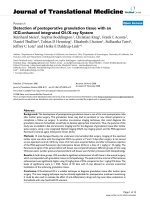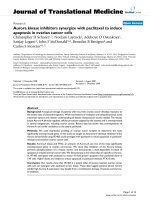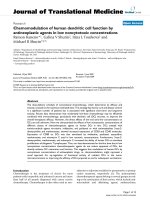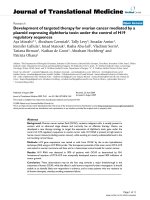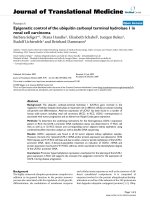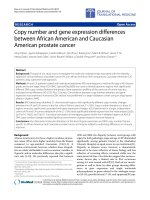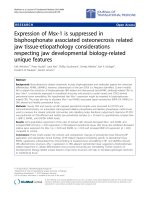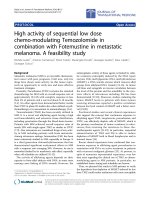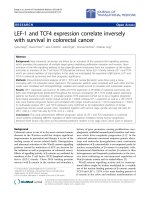báo cáo hóa học:" Triple-Nucleoside Analog Antiretroviral Therapy: Is There Still a Role in Clinical Practice? A Review" docx
Bạn đang xem bản rút gọn của tài liệu. Xem và tải ngay bản đầy đủ của tài liệu tại đây (228.73 KB, 8 trang )
BioMed Central
Page 1 of 8
(page number not for citation purposes)
Journal of the International AIDS Society
Open Access
Review article
Triple-Nucleoside Analog Antiretroviral Therapy: Is There Still a
Role in Clinical Practice? A Review
Harold A Kessler
Address: Professor of Medicine and Immunology/Microbiology, Associate Director, Section of Infectious Diseases, Rush University Medical Center,
Chicago, Illinois
Email: Harold A Kessler -
Abstract
The development and widespread clinical use of coformulated abacavir/lamivudine/zidovudine
(ABC/3TC/ZDV) as Trizivir represented an important advance in the management of HIV-infected
patients, especially those with adherence challenges. With a low pill burden, no food restrictions,
limited drug-drug interactions, and a favorable resistance profile, ABC/3TC/ZDV remains an
alternative option in the US Department of Health and Human Services Consensus Panel
Guidelines as initial treatment in antiretroviral-naive patients. Recent data have shown ABC/3TC/
ZDV to be less efficacious in suppressing and/or maintaining suppression of virologic replication
compared with efavirenz-containing antiretroviral therapy. Although triple-nucleoside/nucleotide
reverse transcriptase inhibitor (t-NRTI) combinations that do not contain a thymidine analog (ZDV
or stavudine) have recently shown high virologic failure rates in clinical trials and clinical practice,
t-NRTI regimens containing a thymidine analog have consistently been shown to be efficacious.
Introduction
The development and widespread clinical use of coformu-
lated abacavir/lamivudine/zidovudine (ABC/3TC/ZDV)
as Trizivir represented an important advance in the man-
agement of HIV-infected patients, especially those with
adherence challenges. With a low pill burden, no food
restrictions, limited drug-drug interactions, and a favora-
ble resistance profile, ABC/3TC/ZDV remains an alterna-
tive option in the US Department of Health and Human
Services (DHHS) Consensus Panel Guidelines as initial
treatment in antiretroviral-naive patients.[1] Recent data
from the AIDS Clinical Trials Group (ACTG) 5095 study,
however, have shown ABC/3TC/ZDV to be less efficacious
in suppressing and/or maintaining suppression of viro-
logic replication compared with efavirenz (EFV)-contain-
ing antiretroviral therapy (ART).[2] Recent data from
clinical trials and clinical practice showing high virologic
failure rates from a number of other triple-nucleoside/
nucleotide reverse transcriptase inhibitor (t-NRTI) combi-
nations[3-8] have led some clinicians to conclude that t-
NRTI-based ART has a limited role, if any, in clinical prac-
tice. However, t-NRTI regimens containing a thymidine
analog (ZDV or stavudine [d4T]) have consistently been
shown to be efficacious.
This article will review the literature and examine the clin-
ical role of t-NRTI-based ART as initial therapy, as switch
therapy, and as part of induction-maintenance strategies.
Triple-Nucleoside Analogs Alone as Initial ART
The concept of using single-class ART as initial treatment
of HIV is based on the potential to preserve future treat-
ment options and to limit long-term side effects of other
antiretroviral classes. In addition, the development of
fixed-dose coformulation products such as Trizivir and
3TC/ZDV (Combivir) helped lower total daily pill burdens
and potentially improve patient adherence. However,
many clinicians are apprehensive about therapies that do
Published: 2 June 2005
Journal of the International AIDS Society 2005, 7:70
This article is available from: />Journal of the International AIDS Society 2005, 7:70 />Page 2 of 8
(page number not for citation purposes)
not target multiple sites of viral replication, especially for
a virus such as HIV, with extremely high error-prone rep-
lication. This apprehension, coupled with high virologic
response rates from combination ART regimens contain-
ing an NRTI backbone with either a nonnucleoside reverse
transcriptase inhibitor (NNRTI) or a protease inhibitor
(PI) (single or boosted with ritonavir), has caused many
clinicians to be cautious, and often confused, about using
t-NRTI in current practice.
Recently, t-NRTI combinations that contain tenofovir
(TDF) have been investigated in prospective and observa-
tional clinical trials and used in clinical practice. A
number of these t-NRTI-based regimens have resulted in
high virologic failure rates; of particular concern has been
the frequent development of the K65R and/or M184V
nucleoside mutations in viral isolates from patients
treated with these regimens. It is, however, important to
note that not all t-NRTI regimens are created equal;
whereas certain t-NRTI regimens have shown high failure
rates, others have not. The data for these various regimens
will be reviewed separately to clarify differences between
viable and nonviable t-NRTI combinations.
ABC/3TC/ZDV and ABC + 3TC + d4T
The most clinical experience with t-NRTI-based ART for
initial treatment of HIV is with ABC/3TC/ZDV. Data from
2 large, randomized prospective clinical trials, CNA 3005
and CNA 3014, resulted in approval by the US Food and
Drug Administration of ABC/3TC/ZDV for treatment of
HIV.[9,10] These trials showed that the t-NRTI regimen is
not as potent as PI-containing regimens, but that it pro-
vides a significant adherence benefit that compensates for
potency in patients with baseline viral load < 100,000
copies/mL. In those with higher baseline viral loads, the t-
NRTI regimen may not be as effective as PI-containing reg-
imens. A third study comparing ABC/3TC/ZDV with EFV-
containing 3- or 4-drug combinations in a blinded fash-
ion found the EFV-based regimens to be more effective at
suppressing viral replication and maintaining that sup-
pression, regardless of baseline viral load, although the
blinded comparison did not allow for real-world dosing
of the t-NRTI regimen.
CNA 3005 was a prospective, multicenter, double-blind,
placebo-controlled trial that randomized 562 treatment-
naive HIV-infected patients with CD4+ cell counts > 100
cells/mcL and plasma HIV RNA > 10,000 copies/mL to
receive ABC (300 mg twice daily) plus 3TC/ZDV (1 tablet
twice daily) or 3TC/ZDV (1 tablet twice daily) plus indi-
navir (IDV; 4 capsules every 8 hours).[9] The blinded
nature of the trial required a total of 16 pills to be taken
daily. Groups were well matched, with the median CD4+
cell count and viral load at baseline approximately 360
cells/mcL and 70,000 copies/mL, respectively. At 48
weeks, median changes in baseline CD4+ cell counts were
similar between groups, and an intention-to-treat (ITT)
analysis found that equal proportions of patients had viral
load measurements < 400 copies/mL (51% ABC + 3TC/
ZDV vs 51% 3TC/ZDV + IDV). The as-treated analysis
showed suppression to < 400 copies/mL in 86% and 94%
of those in the ABC and IDV arms, respectively, 95% con-
fidence interval (CI, -14, 0). Among patients with baseline
viral loads > 100,000 copies/mL, 45/100 (45%) and 30/
96 (31%) reached < 50 copies/mL (ITT) in the IDV and
ABC arms, respectively, 95% CI (-27, 0). The difference in
response to the ABC arm vs the IDV arm among patients
with high baseline viral loads created interest in conduct-
ing a similar comparison in an open-label fashion, which
would allow real-world dosing. Study CNA 3014 was
designed to evaluate whether a potential adherence bene-
fit with the triple-nucleoside regimen would compensate
for concerns about potency with this combination.
CNA 3014 was a prospective, open-label, multicenter,
equivalence (noninferiority) clinical trial that rand-
omized 342 ART-naive HIV-infected patients with CD4+
cell counts > 100 cells/mcL and HIV RNA > 5000 copies/
mL to receive 3TC/ZDV twice daily + ABC twice daily or
3TC/ZDV twice daily + IDV 800 mg 3 times daily.[10]
CNA 3014 differed from CNA 3005 in that it was not
blinded, resulting in a more "real-world" pill burden;
patients receiving 3TC/ZDV + ABC took 4 tablets per day
whereas those in the 3TC/ZDV + IDV arm took 8 tablets/
capsules per day with food and fluid restrictions. Groups
were well matched at baseline: median CD4+ cell counts
were 331 cells/mcL for the 3TC/ZDV + ABC group (n =
169) and 299 cells/mcL for the 3TC/ZDV + IDV group (n
= 173); the median plasma HIV RNA was 4.78 and 4.82
copies/mL for ABC- and IDV-treated patients, respectively.
Equivalence of 3TC/ZDV + ABC and 3TC/ZDV + IDV was
defined as a lower limit of the 95% CI > -15% for the dif-
ference between arms in suppression < 400 copies/mL at
week 48. At 48 weeks, 3TC/ZDV + ABC met the criterion
of equivalence: 66% of patients treated with 3TC/ZDV +
ABC and 50% of those treated with 3TC/ZDV + IDV had
HIV RNA < 400 copies/mL via ITT analysis; 95% CI (6.0,
27.2; P = .002) The ABC arm showed noninferiority in
suppressing to < 400 copies/mL and < 50 copies/mL at all
viral load strata, via ITT analyses. However, 67% of
patients with baseline HIV RNA < 100,000 copies/mL and
48% of patients with baseline HIV RNA > 100,000 copies/
mL who received 3TC/ZDV + ABC achieved viral load
measurements < 50 copies/mL (ITT). In an as-treated, sub-
group analysis that stratified patients by baseline viral
loads, 73% and 59% of those with baseline viral loads >
100,000 copies/mL reached < 50 copies/mL in the IDV
and ABC arms, respectively, 95% CI (-34.1, 5.2); among
those with baseline viral loads between 5000 and 100,000
copies/mL, 90% and 87% in the ABC and IDV arms,
Journal of the International AIDS Society 2005, 7:70 />Page 3 of 8
(page number not for citation purposes)
respectively, reached < 50 copies/mL, 95% CI (-7.5, 14.2).
Changes in the mean absolute CD4+ cell count from base-
line were similar between treatment groups (3TC/ZDV +
ABC group: 148 cells/mcL vs 3TC/ZDV + IDV: 152 cells/
mcL). The differences observed in this trial are believed to
be a result of the pill burden/adherence benefit offered by
the t-NRTI regimen, which may compensate for potency
concerns in patients with baseline viral loads < 100,000
copies/mL, as evidenced by patient self-reported adher-
ence (72% of 3TC/ZDV + ABC patients vs 45% of 3TC/
ZDV + IDV patients reported missing more than 1 dose
over the previous 4 weeks; P < .001).
A third trial, CNAF3007, compared coformulated 3TC/
ZDV + ABC with 3TC/ZDV + nelfinavir (NFV) 3 times
daily in an open-label, multicenter, randomized study of
195 treatment-naive HIV-infected patients.[11] At 48
weeks, similar proportions of ABC- and NFV-treated
patients had HIV RNA < 50 copies/mL (55% for both
treatment groups by ITT analysis). Although greater mean
increases in CD4+ cell counts were observed among 3TC/
ZDV + ABC-treated patients (137 cells/mcL) than among
3TC/ZDV + NFV-treated patients (88 cells/mcL), this was
countered by the higher mean baseline CD4+ cell counts
of patients receiving NFV compared with those who
received ABC (471 vs 390 cells/mcL, respectively). As
expected, there was a higher incidence of diarrhea (47% vs
7%) and a lower incidence of potential hypersensitivity
reactions (0% vs 4%) among NFV-treated patients.
The studies described above compared ABC/3TC/ZDV
with unboosted, high-pill-burden, frequent daily admin-
istration PI-based ART. Although beneficial, these regi-
mens have been shown to be inferior to current
nonnucleoside or pharmacokinetically enhanced boosted
PI-containing ART. In Gilead's 903 trial, which compared
d4T with TDF, both used in combination with 3TC and
EFV, the overall proportion of patients with HIV RNA < 50
copies/mL was 74% and 78% for d4T- and TDF-treated
patients, respectively.[12] In combination with d4T +
3TC, therapy with ritonavir-boosted lopinavir (LPV/r)
produced viral response rates of 74% and 63% for HIV
RNA < 400 and < 50 copies/mL, respectively.[13] One key
trial, however, compared ABC/3TC/ZDV with EFV-con-
taining ART. ACTG 5095 was a double-blind, placebo-
controlled, multicenter trial that randomized, 1147 HIV-
infected, antiretroviral-naive patients 1:1:1 to receive
ABC/3TC/ZDV, 3TC/ZDV + EFV, or ABC/3TC/ZDV +
EFV.[2] Groups were well matched, with a mean CD4+
cell count of 238 cells/mcL and HIV RNA of 4.85 log
10
copies/mL (42% of patients had viral load measurements
> 100,000 copies/mL). At the first interim analysis, the
Data Safety Management Board halted the study because
the t-NRTI underperformed when compared with the
pooled EFV-containing arms, regardless of viral load
strata. Of the 33% of patients who completed 48 weeks of
treatment, 74% of ABC/3TC/ZDV-treated patients and
89% of EFV-treated patients had HIV RNA < 200 copies/
mL; 61% and 74% had viral load measurements < 50 cop-
ies/mL, respectively. Among patients who achieved HIV
RNA < 200 copies/mL at least once, the time to virologic
failure was shorter in the t-NRTI arm than in the EFV arm
(P < .001). In an analysis of the 780 patients with at least
one HIV-1 RNA value < 50 copies/mL, a similar difference
was suggested, but it was not statistically significant (P =
.08).
The CLASS study evaluated the first-line regimens of ABC
+ 3TC + d4T, ABC + 3TC + EFV, and ABC + 3TC + ampre-
navir/ritonavir (APV/r) among 291 antiretroviral-naive
patients.[14] The median baseline HIV RNA and CD4+
cell count were 4.9 log
10
copies/mL (42% with viral load
measurements > 100,000 copies/mL) and 299 cells/mcL,
respectively. At 48 weeks, the EFV treatment arm demon-
strated significant increases in the proportion of patients
with HIV RNA < 50 copies/mL vs the other 2 treatment
groups (76% for EFV, 59% for APV/r, and 62% for d4T; P
= .047 by ITT analysis). These data again show that a t-
NRTI regimen that contains a thymidine analog with 3TC
and ABC has virologic efficacy comparable to that of a PI-
based regimen, but inferior to that of an EFV-based regi-
men.
ZDV or d4T + ABC and 3TC as Initial ART: Discussion
Although data show that ABC may be equivalent to NFV
and APV/r, and potentially superior to IDV, when com-
bined with d4T or ZDV + 3TC, the overall response rates
are lower than those seen in clinical trials comparing these
t-NRTI regimens with EFV-containing ART, which is rec-
ommended as a preferred initial option in combination
with 2 NRTIs by the DHHS guidelines.[1] The coformula-
tion of the boosted PI, LPV/r, combined with 2 NRTIs, is
the other regimen recommended by the DHHS guidelines
as a preferred initial therapy.[1] In ACTG 5095, the overall
rate of virologic success in the ABC/3TC/ZDV treatment
arm (74% < 200 copies/mL) was considerable, albeit infe-
rior to the pooled EFV arms. In 3 other large randomized,
controlled clinical trials mentioned above, ABC + 3TC +
ZDV consistently showed similar efficacy results.[9-11]
Although virologic suppression and durability of response
are priorities of initial therapy, consideration must also be
given to future treatment options if virologic failure
occurs. The use of d4T or ZDV in combination with ABC
and 3TC preserves classes, whereas EFV-based regimens
often compromise future activity of at least 1 antiretrovi-
ral class. Among the 43 patients who experienced viro-
logic breakthrough or were never fully virologically
suppressed in CNA 3005, the development of any muta-
tion other than M184V was infrequent.[15] Upon initial
Journal of the International AIDS Society 2005, 7:70 />Page 4 of 8
(page number not for citation purposes)
virologic breakthrough, 84% of patients had an M184V or
wild-type viral isolate on genotypic testing. Of the 28
patients who continued ABC + 3TC/ZDV despite having
continued viral replication, the development of thymi-
dine analog mutations (TAMs) was slow, with only 25%
of isolates showing TAMs at 6 months. Similar results
were seen among isolates evaluated from patients experi-
encing virologic failure on ABC/3TC/ZDV in ACTG
5095.[2] Of the 82 patients experiencing virologic failure
on ABC/3TC/ZDV, 57% had M184V alone or wild-type
virus, 11% had M184V plus an NRTI mutation, and 2%
had NRTI mutations alone (27% had HIV RNA < 500 cop-
ies/mL and 4% could not be sequenced). In contrast, viro-
logic failure with an EFV-based regimen has been shown
to produce a high rate of NNRTI mutations that confer
cross-resistance to the other agents in this class.
Consequently, initial therapy with ABC/3TC/ZDV or d4T
+ 3TC + ABC remains a viable option among patients
unwilling to take EFV- or LPV/r-based ART. Among
patients with baseline viral load measurements > 100,000
copies/mL, the benefits and convenience of ABC/3TC/
ZDV must be weighed against its lower potency compared
with those of NNRTI- or PI-based regimens. As suggested
by the results of CNA 3014, the fixed-dose formulation of
ABC/3TC/ZDV, with its lower pill burden, represents a
potentially beneficial treatment option for patients with
adherence-related issues. In contrast to NNRTI-containing
ART, early treatment failure with ABC/3TC/ZDV or d4T +
3TC + ABC, which usually results from the development
of the M184V mutation, creates little cross-resistance to
other NRTIs.
Nonthymidine-Containing ("TAM-Sparing") t-NRTI
Regimens as Initial ART
Clinical trials that have investigated the use of TDF as part
of the NRTI backbone of an ART regimen among treat-
ment-naive patients have shown this agent to be highly
potent and well tolerated, with resultant durable treat-
ment responses. Because TDF has potency against HIV
when administered once daily with or without food, as
well as a resistance profile different from that of ZDV and
d4T, 2 TDF-containing once-daily t-NRTI regimens have
been evaluated as initial ART.[3,6,8,16] Although these
regimens have contained 3 nucleoside analogs highly
potent against HIV, a number of prospective and observa-
tional trials have unfortunately shown high rates of treat-
ment failure with viruses that contain the K65R and/or
M184V mutation(s).
The largest prospective study to date has been Glaxo-
SmithKline's ESS30009 trial, which was a randomized,
prospective, open-label, multicenter trial in antiretroviral-
naive patients. The study evaluated the investigational
fixed-dose formulation of ABC 600 mg plus 3TC 300 mg
(ABC/3TC) given once daily in combination with either
EFV 600 mg once daily or TDF 300 mg once daily.[6] A
total of 194 patients were enrolled in the study when an
interim analysis, conducted on patients who had received
at least 8 weeks of therapy, demonstrated high rates of
inadequate virologic suppression among patients receiv-
ing ABC/3TC + TDF. Of the 102 patients randomized to
receive TDF, 50 (49%) failed to achieve either a 2-log
10
copies/mL decrease from baseline or had a 1-log
10
copies/
mL or greater increase above the nadir viral load on any
subsequent visit. In contrast, only 5 of 92 patients (5%)
on ABC/3TC + EFV experienced inadequate virologic sup-
pression. Among patients with defined virologic nonre-
sponse to ABC/3TC + TDF who could be genotyped (n =
36), 23 (64%) had K65R plus M184V and 13 (36%) had
M184V/I alone.
The TONUS trial studied the ABC + 3TC + TDF combina-
tion in 38 patients, with a median CD4+ cell count of 222
cells/mcL and a median viral load of 4.87 log
10
copies/
mL.[16] The study was stopped prematurely because of
poor results: 12 (33%) of 36 enrolled patients experi-
enced virologic failure by week 24. The response corre-
lated with baseline viral load: Therapy failed in 64% of
those with baseline viral loads > 5 log
10
copies/mL, com-
pared with 29% of those with viral loads between 4 and 5
log
10
copies/mL, and none of the 8 patients with baseline
viral loads < 4 log
10
copies/mL. Among the 11 patients
whose resistance data after virologic failure were available,
9 had both the M184V and K65R mutations and 2 had
M184V alone. The investigators examined drug levels,
because there has been speculation about whether drug
interactions could explain the poor results seen with such
regimens. The 4-week plasma C
min
was adequate for all 3
drugs in 86% of patients, and there was no relationship
between trough concentration and virologic response.
Data on intracellular drug concentrations showed that the
active triphosphate metabolites of at least one of the drugs
were detected in all patients. These data suggest that the
poor virologic outcome for this combination of drugs is
not due to an adverse pharmacologic interaction.
Farthing and colleagues[3] presented data from a small
prospective, observational, pilot study in which 19
antiretroviral-naive patients received once-daily ABC 600
mg, 3TC 300 mg, and TDF 300 mg. At week 8, 11 patients
(58%) experienced treatment failure, defined as less than
a 2-log
10
decline from baseline in HIV RNA or viral
rebound after initial suppression; only 5 patients were
defined as treatment successes. Similar to the results of
ESS30009, the majority of patients had M184V alone (n =
5) or M184V plus K65R (n = 4) on genotypic evaluation.
Recently, a small, prospective, open-label study of TDF +
didanosine (ddI) + 3TC in 24 antiretroviral-naive patients
Journal of the International AIDS Society 2005, 7:70 />Page 5 of 8
(page number not for citation purposes)
was terminated early because of high rates of virologic
failure (91% of patients at 12 weeks); resistance testing of
21 patients revealed M184V/I in 20 patients, of whom 10
also had K65R.[8]
Several retrospective studies have evaluated the use of t-
NRTI-based ART. Winston and colleagues[7] analyzed all
genotypes within their clinic for K65R. K65R was associ-
ated with the antiretroviral combinations of ABC+ ddI +
TDF or dual use of ddI + TDF-containing regimens. Of the
42 patients who received ABC + ddI + TDF and resistance
testing (n = 22), 9 (41%) developed K65R. Patients who
did not receive ABC + ddI + TDF or who concurrently
received a thymidine analog were significantly less likely
to develop K65R. Ruane and colleagues[4] identified 13
cases of K65R among 51 patients who received TDF-con-
taining ART with expected or documented wild-type
reverse transcriptase prior to initiation of TDF. The use of
once-daily ABC + 3TC + TDF (n = 6) and ddI + 3TC + TDF
(n = 3) accounted for most of the treatment failures. Gen-
otypic testing demonstrated 10 patients with M184V plus
K65R. MacArthur and colleagues[5] found that the combi-
nation of ddI + TDF (plus any other agent) was associated
with an increased incidence of K65R compared with other
combinations (12 of 182 patients; 6.6%).
Several potential explanations have been postulated as to
why there have been such high failure rates among these
nonthymidine analog t-NRTI-based regimens.[17] The
most plausible explanation is the use of 3 NRTIs that both
have low genetic barriers to selection of resistant viruses
and select for the K65R and/or M184V mutations. In addi-
tion, as discussed above, the t-NRTI regimens are not as
potent as NNRTI- or PI-based regimens, which may also
contribute to the rapid selection of resistant virus with a
subsequent high virologic failure rate. The most common
regimens associated with high rates of early failure have
included ABC + 3TC + TDF, ddI + 3TC + TDF, and ABC +
ddI + TDF. All of these agents appear to have decreased
activity against HIV with K65R in vitro. When any 2 of
these NRTIs have been evaluated in combination regi-
mens with either an NNRTI or a PI, these types of treat-
ment failures have not been observed. This is likely due to
the enhanced potency of these regimens and lowered
selection pressure on the K65R and M184V mutant virus
populations.
If t-NRTI is to be employed, these regimens should con-
tain a thymidine analog, if possible. In vitro data suggest
that K65R antagonizes primer unblocking, the main
mechanism of resistance to thymidine analogs.[18] As a
result, the thymidine analogs appear to be resensitized,
and the use of thymidine analogs appears to decrease the
likelihood of K65R development. If a thymidine analog
cannot be used, an additional agent with activity against
K65R should be employed (eg, an NNRTI or a
boosted PI).
In conclusion, it cannot be overemphasized that clini-
cians should not use these inadequate t-NRTI regimens to
treat HIV infection.
Triple Nucleosides Alone as Switch Therapy
In hopes of decreasing pill burdens, preserving future
treatment options, and potentially lowering the risk of
drug-induced adverse effects such as lipodystrophy and
hyperlipidemia, many clinicians and investigators have
switched patients from a fully suppressive NNRTI- or PI-
containing regimen to a t-NRTI regimen. This strategy has
only been proven effective in patients who had been viro-
logically suppressed for an extended period at the time of
the switch.[19-22] One of the most commonly investi-
gated switch strategies has involved replacing a PI with
ABC among patients receiving 2 other NRTIs, resulting in
a triple-nucleoside regimen. Once again, however, clini-
cians should consider such a switch only if the t-NRTI reg-
imen has been proven to be adequate.
CNA30017 was a randomized, multicenter, open-label
study that enrolled 311 HIV-infected patients who were
receiving 2 NRTIs plus a PI, had undetectable HIV RNA
since starting ART, and were receiving current therapy for
more than 6 months.[19] The enrolled patients either
continued their current regimen (n = 103) or switched the
PI to ABC (n = 104). Over time, a significantly greater
number of continuation patients experienced treatment
failure as opposed to those who switched to t-NRTI (n =
12, t-NRTI vs n = 24, continuation; P = .03). The main
cause of treatment failure in the continuation arm was
adverse drug events (n = 14); few patients in either arm
experienced virologic failure (n = 4, t-NRTI vs n = 2, con-
tinuation).
TRIZAL was a randomized, prospective, open-label switch
study that evaluated patients who were receiving any tri-
ple-ART regimen and had HIV RNA < 400 copies/mL for 6
or more months, had been on the same regimen for more
than 6 months, and had HIV RNA < 50 copies/mL at
screening.[20] Enrolled patients either continued their
current therapy or the entire regimen was switched to
ABC/3TC/ZDV; 103 continued their current regimens and
106 patients switched to ABC/3TC/ZDV. The groups were
well matched at baseline; however, 15% of patients who
switched to ABC/3TC/ZDV had received prior mono- or
dual-NRTI therapy. At 48 weeks, 75% of ABC/3TC/ZDV-
treated patients and 69% of continued therapy-treated
patients had HIV RNA < 50 copies/mL via ITT analysis.
Virologic rebound was infrequent; 5 ABC/3TC/ZDV-
treated patients and 1 continued-therapy patient experi-
enced HIV RNA > 400 copies/mL. Three of the 5 ABC/
Journal of the International AIDS Society 2005, 7:70 />Page 6 of 8
(page number not for citation purposes)
3TC/ZDV-treated patients with virologic rebound had
received prior mono- or dual-NRTI treatment.
Martinez and colleagues[22] randomized 460 patients
who were receiving PI-containing triple-drug ART and had
HIV RNA levels < 200 copies/mL for at least the previous
6 months to switch the PI to nevirapine (NVP, n = 155),
EFV (n = 156), or ABC (n = 149). Groups were well
matched at baseline with roughly one half of patients in
each treatment arm having received mono- or dual-NRTI
therapies prior to their PI-based ART. At 12 months, 10%
of NVP-treated, 6% of EFV-treated, and 13% of ABC-
treated patients reached a predefined endpoint of death,
progression to AIDS, or HIV RNA > 200 copies/mL (P =
.10). Fasting plasma triglyceride and cholesterol levels
rose among all 3 treatment groups; however, ABC-treated
patients had significantly lower increases compared with
the NNRTI groups (P < .001). The rates of adverse drug
events requiring study discontinuation were significantly
higher among NNRTI-treated patients than among those
who received ABC; however, no differences were observed
between EFV and NVP. Among the 28 patients who
received ABC and experienced virologic failure, 23 (82%)
had received prior nonsuppressive ART with single or dual
NRTIs alone. These data, as well as those from TRIZAL,
show that if a patient is to be switched to t-NRTI, a thor-
ough and detailed history of prior ART is necessary to pre-
vent virologic breakthrough following the switch. It is also
evident that a switch to ABC in patients who initiated HIV
therapy with at least 3 drugs is a safe and effective strategy
that is comparable to NNRTI-switch strategies.
The use of PI-sparing regimens has gained interest because
many of the older PI-containing regimens often increase
fasting cholesterol and triglyceride values and may cause
lipoaccumulation disorders. The evaluation of switch
therapy to t-NRTI has, therefore, been investigated among
patients receiving PI-based ART who have hyperlipidemia.
ESS40003 was an open-label pilot study that assessed
antiretroviral efficacy and lipid changes among patients
experiencing hyperlipidemia when switching from a PI to
ABC.[23] Patients were included in the study if they had
been on their current dual NRTI plus PI-based regimen for
more than 3 months, had HIV RNA < 400 copies/mL on
their last 2 consecutive clinic visits, had HIV RNA < 50
copies/mL and fasting total cholesterol > 200 mg/dL at
screening, and were not currently receiving any choles-
terol- or triglyceride-lowering medication. A total of 144
patients were randomized to either continue their current
PI-based ART (n = 52) or switch their PI to ABC (n = 52).
At 28 weeks, 62% of ABC-treated patients and 75% of
continued PI-treated patients had HIV RNA < 50 copies/
mL. There was no significant difference in time to treat-
ment failure between the 2 arms (P = .397).[23] A careful
evaluation of the causes of treatment failure showed that
the majority of ABC failures occurred early following the
switch and were a direct result of new or suspected adverse
drug events; only 3 ABC-treated patients experienced viro-
logic failure (defined as HIV RNA > 1000 copies/mL on 2
consecutive occasions). Compared with patients who
continued PI therapy, patients switched to ABC experi-
enced greater reductions from baseline in total cholesterol
(-39 mg/dL vs -0.6 mg/dL; P < .001), low-density lipopro-
tein (LDL) cholesterol (-24 mg/dL vs -4 mg/dL; P = .016),
and triglycerides (-109 mg/dL vs +47 mg/dL; P = .019).
The NEFA (nevirapine, efavirenz, abacavir) lipid substudy
evaluated the fasting lipid profiles of 92 patients who
were receiving stable PI-based ART (HIV RNA < 200 cop-
ies/mL for more than 6 months) and who were switched
to NVP (n = 30), EFV (n = 33), or ABC (n = 29).[24] Data
evaluating the effects of the switch on 69 patients follow-
ing 24 months of treatment (n = 22 ABC, n = 21 EFV, n =
26 NVP) were recently presented. Patients who switched
to either NVP or EFV had minimal changes in total choles-
terol (NVP +2%; EFV, -6%), modest decreases in LDL cho-
lesterol (NVP, -17%; EFV -10%), and significant increases
in high-density lipoprotein (HDL) cholesterol (NVP,
+50%; EFV, +12%). Patients who switched to ABC had
significant decreases in total cholesterol (-13%) and LDL
cholesterol levels (-15%). Triglyceride levels in all 3
groups remained relatively unchanged.
Because the efficacy of ABC/3TC/ZDV alone as initial ther-
apy has been shown to be lower when the baseline HIV
RNA is > 100,000 copies/mL, some clinicians are reluctant
to switch patients on ART with nondetectable HIV RNA to
ABC/3TC/ZDV if the baseline HIV RNA was > 100,000
copies/mL. Moyle and colleagues[21] retrospectively eval-
uated 32 patients who had received ART, achieved HIV
RNA < 50 copies/mL, and were switched to ABC/3TC/
ZDV despite baseline HIV RNA > 100,000 copies/mL prior
to initiation of ART. The median pre-ART HIV RNA was
193,093 copies/mL with a median CD4+ cell count of 155
cells/mcL (12 of 32 [38%] had CD4+ cell counts < 100
cells/mcL). Patients had received initial ART for a median
of 28 months prior to switch, with a median CD4+ cell
count of 447 cells/mcL at the time of switch. After a
median of 6.5 months from the time of switch to ABC/
3TC/ZDV, no patient experienced virologic failure. Rand-
omized, prospective clinical trials with long-term follow-
up are needed to validate these encouraging findings.
A recent report evaluated the strategy of switching patients
on stable ART to ABC + 3TC + TDF.[25] A retrospective
evaluation of 8 patients without history of treatment fail-
ure on any prior antiretroviral regimen and on stable ART
for a median of 14.2 months (range: 7.567.5 months)
were switched to ABC + 3TC + TDF. Five of the 8 patients
experienced virologic failure following the switch at a
Journal of the International AIDS Society 2005, 7:70 />Page 7 of 8
(page number not for citation purposes)
median of 130 days; 4 of the 5 had the K65R mutation,
the M184V/I mutation, or both. Consequently, the use of
this regimen for simplification of therapy cannot be rec-
ommended.
Simplification With t-NRTI: Discussion
The use of t-NRTIs as switch therapy for patients receiving
stable ART for simplification and/or improvement in lipid
abnormalities has proven effective for patients who initi-
ated a PI- or NNRTI-based regimen with at least 3 agents,
regardless of baseline viral load. However, this strategy
should be used in patients with little to no prior treatment
with mono- or dual-NRTI therapies, as these patients are
more likely to experience virologic breakthrough follow-
ing the switch. In addition, the t-NRTI should be carefully
selected. Most studies have a thymidine analog in combi-
nation with 3TC, with ABC substituted for a PI, with lim-
ited treatment failures. In contrast, switching to regimens
with low genetic barriers (eg, ABC + 3TC + TDF) appears
to confer a high risk for virologic breakthrough. Although
ABC/3TC/ZDV has decreased activity when used as initial
therapy in patients with baseline viral loads > 100,000
copies/mL, it appears that once the patient's virus is fully
controlled (as evidenced by prolonged viral suppression),
ABC/3TC/ZDV may provide durable treatment benefit in
a simplification/switch strategy.
Triple Nucleosides Alone When Used for Maintenance
Therapy
The concept of induction-maintenance has garnered inter-
est from both clinicians and researchers. This strategy
involves starting patients on potent ART and changing to
a simpler, more convenient and potentially less toxic reg-
imen once the viremia is controlled and the immune sys-
tem reconstituted. In the past, these strategies have not
produced good results, but this may have been because
the maintenance regimens employed were not highly
potent (eg, indinavir monotherapy, 3TC/ZDV alone). A
number of prospective studies have shown benefit of
quadruple-based ART (eg, ABC/3TC/ZDV + EFV) as initial
therapy, especially among patients with high baseline
viral load measurements. The concept of using ABC/3TC/
ZDV as maintenance therapy following induction with
quadruple-based ART has been investigated.
SUBURBS was a small open-label pilot study that evalu-
ated the quadruple-based regimen of ABC/3TC/ZDV +
EFV as initial ART for treatment-naive patients.[26] Fol-
lowing 48 weeks of treatment, patients with HIV RNA < 50
copies/mL and CD4+ cell counts > 100 cells/mcL (n = 20)
were switched to ABC/3TC/ZDV alone. At 48 weeks fol-
lowing the switch, 85% of patients had maintained HIV
RNA < 50 copies/mL with continued immunologic bene-
fit, as evidenced by CD4+ cell count increases. In addition,
significant declines in total cholesterol values were
observed when EFV was discontinued (-29.1 mg/dL; P =
.0002). Of the 3 patients who experienced treatment fail-
ure, only 1 had documented virologic failure that was not
a result of poor adherence or an adverse drug event. A
large, prospective, multicenter trial (ESS40013) is cur-
rently under way to evaluate induction with ABC/3TC/
ZDV + EFV for 48 weeks followed by randomization to
continued ABC/3TC/ZDV + EFV or a switch to ABC/3TC/
ZDV alone.[27] To date, only data from the induction
phase have been presented.
Although the concept of induction-maintenance with t-
NRTI-based ART specifically ABC/3TC/ZDV alone
appears promising, only limited data currently support its
use. More information will be available in the near future
when the maintenance phase of ESS40013 is completed
and the data are reported.
Conclusion
Whereas recent data have cast doubt on the widespread
use of t-NRTI-based ART in general, not all t-NRTI-based
regimens are the same. Some regimens, such as ABC/3TC/
ZDV and d4T + ABC + 3TC, have produced good results
when used as initial therapy, for simplification, and
potentially as a maintenance regimen in induction-main-
tenance strategies. When used as initial therapy, these reg-
imens have been shown to be less potent than current
NNRTI-based ART; however, when adherence is an issue,
or when the patient is unwilling or unable to take
NNRTIs, t-NRTI regimens remain viable options. When
considering whether to use ABC/3TC/ZDV in patients
with baseline HIV RNA > 100,000 copies/mL, clinicians
should weigh the benefits of low pill burden and conven-
ience vs decreased potency. Other t-NRTI regimens have
produced high virologic failure rates when employed
either as initial ART or as switch therapy. Regimens such
as ABC + 3TC + TDF, ABC + ddI + TDF, and ddI + 3TC +
TDF include agents that are highly potent against HIV but
are limited by a low genetic barrier to resistance, especially
to the cross-resistant K65R viral isolate. When t-NRTI reg-
imens are desired, inclusion of a thymidine analog should
be considered, because it appears that these agents
decrease the risk of developing K65R.
Funding Information
This research contained in this article was supported by an
unrestricted educational grant from GlaxoSmithKline.
Authors and Disclosures
Harold A. Kessler, MD, has disclosed that he has received
honoraria from, and is on the speaker's bureaus of, Glax-
oSmithKline, Abbott Laboratories, Bristol-Myers Squibb,
Roche, Pfizer, Gilead, and OrthoBiotech. He has received
research grants from Abbott Laboratories, Merck, Glaxo-
SmithKline, Bristol-Myers Squibb, Gilead Sciences, Boe-
Journal of the International AIDS Society 2005, 7:70 />Page 8 of 8
(page number not for citation purposes)
hringer Ingelheim, and Tibotec. He is a consultant for
GlaxoSmithKline, Gilead, OrthoBiotech, and Bristol-
Myers Squibb. He is a stock holder in GlaxoSmithKline,
Abbott, Pfizer, and Bristol-Myers Squibb.
Acknowledgements
I would like to thank Brett Moskowitz for editorial assistance.
References
1. Department of Health and Human Services: Guidelines for the use
of antiretroviral agents in HIV-1-infected adults and adoles-
cents. 2005 [ />AA_040705.pdf]. Accessed May 23, 2005
2. Gulick RM, Ribaudo HJ, Shikuma CM, for the AIDS Clinical Trials
Group Study A5095 Team, et al.: Triple-nucleoside regimens ver-
sus efavirenz-containing regimens for the initial treatment
of HIV infections. N Engl J Med 2004, 350:1850-1861. Abstract
3. Farthing C, Khanlou H, Yeh V: Early virologic failure in a pilot
study evaluating the efficacy of once daily abacavir (ABC),
lamivudine (3TC) and tenofovir DF (TDF) in treatment
naive HIV-infected patients. Program and abstracts of the 2nd Inter-
national AIDS Society Conference on Pathogenesis and Treatment; July
1316, 2003; Paris, France . Abstract 43
4. Ruane P, Luber A, Akil B, et al.: Factors influencing selection of
K65R mutation among patients receiving tenofovir (TDF)
containing regimens. Program and abstracts of the 2nd International
AIDS Society Conference on Pathogenesis and Treatment; July 1316, 2003;
Paris, France . Abstract 582
5. MacArthur RD, Crane LR, Alvarez D, Fairfax M, Richmond D, Curtis
G: Factors associated with selection of the K65R mutation: A
retrospective chart review. Program and abstracts of the 2nd Inter-
national AIDS Society Conference on Pathogenesis and Treatment; July
1316, 2003; Paris, France . Abstract 835
6. Gallant JE, Rodriguez AE, Weinberg W: Early non-response to
tenofovir DF (TDF) + abacavir (ABC) and lamivudine (3TC)
in a randomized trial compared to efavirenz (EFV) + ABC
and 3TC: ESS30009 unplanned interim analysis. Program and
abstracts of the 43rd Interscience Conference on Antimicrobial Agents and
Chemotherapy; September 1417, 2003; Chicago, Illinois . Oral presenta-
tion H-1722a
7. Winston A, Pozniak A, Gazzard B, Nelson M: Which nucleoside
and nucleotide backbone combinations select for the K65R
mutation in HIV-1 reverse transcriptase? Program and abstracts
of the 12th International HIV Drug Resistance Workshop; June 1014,
2003; Los Cabos, Mexico . Abstract 137
8. Jemsek J, Hutcherson P, Harper E: Poor virologic responses and
early emergence of resistance in treatment naive, HIV-
infected patients receiving a once daily triple nucleoside reg-
imen of didanosine, lamivudine and tenofovir DF. Program and
abstracts of the 11th Conference on Retroviruses and Opportunistic Infec-
tions; February 811, 2004; San Francisco, California . Abstract 51
9. Staszewski S, Keiser P, Montaner J, et al.: Abacavir-lamivudine-
zidovudine vs indinavir-lamivudine-zidovudine in antiretro-
viral-naive HIV-infected adults: A randomized equivalence
trial. JAMA 2001, 285:1155-1163. Abstract
10. Vibhagool A, Cahn P, Schechter M, et al.: Triple nucleoside treat-
ment with abacavir plus the lamivudine/zidovudine combi-
nation tablet (COM) compared to indinavir/COM in
antiretroviral therapy-naive adults: Results of a 48 week
open-label, equivalence trial (CNA3014). Curr Med Res Opin
2004, 20:1103-1114. Abstract
11. Matheron S, Brun Vezinet F, Katlama C, et al.: Combivir/abacavir
vs Combivir/NFV as first-line therapy: 48 week results
(CNAF3007/Ecureuil). Program and abstracts of the 5th International
Congress on Drug Therapy in HIV Infection; October 2226, 2000; Glasgow,
United Kingdom . Poster 15
12. Staszewski S, Gallant JE, Pozniak AL, et al.: Efficacy and safety of
tenofovir DF (TDF) versus stavudine (d4T) when used in
combination with lamivudine and efavirenz in antiretroviral
naive patients: 96-week preliminary interim results. Program
and abstracts of the 10th Conference on Retroviruses and Opportunistic
Infections; February 1014, 2003: Boston, Massachusetts . Abstract 564b
13. Ruane P, Mendonca J, Timerman A, et al.: Kaletra vs nelfinavir in
antiretroviral-naive subjects: Week 60 comparison in a
phase III, blinded, randomized clinical trial. Program and
abstracts of the 1st International AIDS Society Conference on Pathogenesis
and Treatment; July 811, 2001; Buenos Aires, Argentina . Abstract 6
14. Bartlett JA, Johnson J, Herrera G, et al.: Abacavir/lamivudine
(ABC/3TC) in combination with efavirenz (NNRTI), ampre-
navir/ritonavir (PI) or stavudine (NRTI): ESS40001 (CLASS)
preliminary 48 week results. Program and abstracts of the 14th
World AIDS Conference; July 811, 2002; Barcelona, Spain . Abstract
TuOrB1189
15. Melby T, Tortell S, Thorborn D, et al.: Time to appearance of
NRTI-associated mutations and response to subsequent
therapy for patients on failing ABC/COM. Program and abstracts
of the 8th Conference on Retroviruses and Opportunistic Infections; Febru-
ary 48, 2001; Chicago, Illinois . Abstract 448
16. Landman R, Peytavin G, Descamps D, et al.: Low genetic barrier to
resistance is a possible cause of early virologic failures on
once-daily regimen of abacavir, lamivudine, and tenofovir:
The TONUS Study. Program and abstracts of the 11th Conference
on Retroviruses and Opportunistic Infections; February 811, 2004. San
Francisco, California . Abstract 52
17. Ruane P, Luber AD: Expert Column: Possible causes of early
treatment failure with a novel ARV regimen. Medscape HIV/
AIDS 2003): [www.medscape.com/viewarticle/460673
]. Accessed
April 21, 2005
18. Parikh U, Koontz D, Hammond J, et al.: K65R: a multi-nucleoside
resistance mutation of low but increasing frequency. Program
and abstracts of the 12th International HIV Drug Resistance Workshop;
June 1014, 2003; Los Cabos, Mexico . Abstract 136
19. Clumeck N, Goebel F, Rozenbaum W, CNA30017 Study Team, et al.:
Simplification with ABC-based triple nucleoside therapy vs
continued PI-based ART in HIV-1-infected patients with
undetectable plasma HIV-1 RNA (CNA300017). AIDS 2001,
15:1517-1526. Abstract
20. Katlama C, Fenske S, Gazzard B, et al.: AZL30002 European study
team. TRIZAL study: switching from successful HAART to
Trizivir (abacavir-lamivudine-zidovudine combination tab-
let): 48 weeks efficacy, safety and adherence results. HIV Med
2003, 4:79-86. Abstract
21. Moyle G, Gazzard BG: Switching to zidovudine plus lamivudine
plus abacavir maintains viral suppression in patients with
high viral load before antiretroviral therapy: a retrospective
clinical cohort analysis. AIDS 2002, 16:1086-1087. Abstract
22. Martinez E, Arnaiz JA, Podzamczer D, et al.: Substitution of nevi-
rapine, efavirenz, or abacavir for protease inhibitors in
patients with Human Immunodeficiency Virus infection. N
Engl J Med 2003, 349:1036-1046. Abstract
23. Keiser P, Sension M, DeJesus E, et al.: Simplification of PI-based
ART with ABC improves hyperlipidemia and maintains viral
suppression in HIV-1 infected adults (ESS40003). Program and
abstracts of the 14th World AIDS Conference; July 811, 2002; Barcelona,
Spain . Abstract 6267
24. Fisac C, Fumero E, Crespo M, et al.: Metabolic changes in patients
switching from a protease inhibitor-containing regimen to
abacavir, efavirenz or nevirapine: 24 month results of a ran-
domized study. Program and abstracts of the 11th Conference on Ret-
roviruses and Opportunistic Infections; February 811, 2004; San Francisco,
California . Abstract 78
25. Hoogewerf M, Regez RM, Schouten WE, Weigel HM, Frissen PH,
Brinkman K: Change to abacavir-lamivudine-tenofovir combi-
nation treatment in patients with HIV-1 who had complete
virological suppression. Lancet 2003, 362:1979-1980. Abstract
26. De Truchis P, Force G, Chemlal K, et al.: An open-label study to
evaluate safety and efficacy of switch to TZV maintenance
treatment after first-line quadruple induction therapy: SUB-
URBS. Program and abstracts of the 8th; October 2931, 2001; Athens,
Greece . Abstract 76
27. Markowitz M, Lang JM, DeJesus E, et al.: Induction of antiretrovi-
ral-naive HIV-infected subjects with Trizivir (TRV) and Sus-
tiva (EFV) for 48 weeks (ESS40013). Program and abstracts of the
International AIDS Society 2nd Conference on Pathogenesis and Treatment;
July 1316, 2003. Paris, France . Abstract 42
